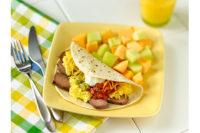
Taste-conscious shoppers are putting product freshness near the top of their protein hierarchy—and stimulating an array of recloseable-packaging initiatives.
In an effort to extend the life of meats and also enhance customer convenience, merchandisers are leveraging packages that seal tighter and are easier to use.
Many deli lunchmeats, for instance, which at one time were enhanced with press-to-close zippers, now sport slider zippers after complaints from shoppers that it was difficult lining up the press-to-close materials.
Slider zippers, meanwhile, have been enhanced with plastic covers that users must tear to access the zipper. The design is intended to prevent the zipper from opening prematurely.
Also prominent are reusable tubs that resemble Tupperware and contain lunchmeat packets.
Newer designs include trays with snap-on lids, which can be used on retail pegboards or stand or lay flat on displays, and recloseable films with adhesive layers.
“Recloseable packaging is one of the consumer’s top priorities,” says Jennifer Sagert, senior packaging scientist with Austin, Minn.-based Hormel Foods Corp. “They now expect it, as it enables them to easily store opened meats rather than transferring the food to a container or their own Ziploc bags.”
Merchandisers frequently base their packaging decisions on price. Huston Keith, principal at Keymark Associates, a Marietta, Ga.-based packaging consulting firm, says it costs about 2 to 3 cents to add a zipper to a bag, several additional cents to attach a slider and even more for a tub.
In addition to material costs, suppliers also must weigh the time and expense of enhancing or replacing processing machinery to support new packaging systems. Sagert notes that some manufacturers are reluctant to initiate changes because they fear processing line speed would be compromised and that the equipment would take up more space. Environmentally conscious companies, including Hormel, meanwhile, are eschewing tubs because of its non-recyclable packaging materials, she states.
“Tubs also don’t necessarily keep a product fresher unless all the oxygen is removed,” Sagert adds. “There is no difference in freshness between products in a tub and in a zipper package. But it is easier for consumers to know that a tub is closed and they also like its reusable feature.”
She states that once exposed to air, lunchmeats in both zipper and tub packaging typically have a two- to five-day shelf life. While recloseable packaging is being used to merchandise wide varieties of meats, it has become a necessity for mid-scale and premium product lines, Keith says.
“It may not be required for lower-end items, such as bologna and frankfurters, but consumers expect resealable packaging for the higher-priced products,” he states.
Though recloseable packaging is prominent in supermarket deli, its use is still minimal in meat departments.
Keith notes that focus groups rarely mention the need for a recloseable feature for fresh beef, chicken and pork. Shoppers who buy meat and poultry in foam trays tend to cook the entire product at once or freeze it for later use, he states.






